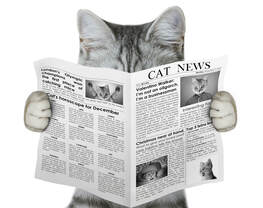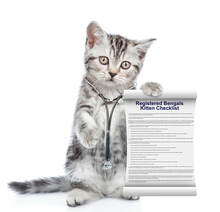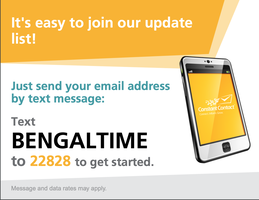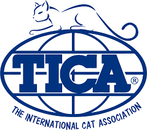Bengal cats are great animals fun and loving. They really are amazing creatures. They're a cross between a Domestic Feline and an
Asian Leopard Cat. The Bengal cat has desirable appearance with gentle cat temperament. The females weigh from 7-11 pounds and the males weigh from 8 -12 pounds. This breed of cat is not only a loving companion but its extremely intelligent.
Most people feel they have a personality more like a dog than a cat because they are very people oriented.
What About Cat Allergies?
Bengals are a wise choice for people with allergies; their sleek, tightly pelted coat seems to hold less
allergens. Sufferers claim that they can tolerate close facial contact with no reactions. Let me clarify that
when the claim is made that the Bengal Cat is hypoallergenic, the dictionary definition of hypoallergenic is
"Having a decreased tendency to provoke an allergic reaction"
Therefore, we are saying that Bengals are not as likely to cause the same type, or level,
of allergic reaction as do many other domestic cat.
Bengal cats are a wise choice for children with allergies, their sleek, soft, tightly pelted coat seems to hold less allergens. The shed very little due to the fact that they have a pelt of fur. which they inherit from their ancestor the Asian Leopard Cat.
The International Cat Association (T.I.C.A.) recognizes several Bengal colors (brown, seal lynx point, mink, sepa, silver)
and patterns (spotted and marbled) for competition.
In 1984 The Domestic Bengal became recognized by the International Cat Association (T.I.C.A.) and was the eligible to be shown. Bengals must be four or more generations removed from their wild, ALC ancestor and have three consecutive generations of Bengal to Bengal breeding in order to be eligible to be shown in T.I.C.A.
F-1 ALC parent X domestic Bengal parent
F-2 F-1 parent X domestic Bengal parent (has an ALC grandparent)
F-3 F-2 parent X domestic Bengal parent ( has an ALC great-grandparent)
F-4 F-3 parent X domestic Bengal parent (has an ALC great-great-grandparent)
Asian Leopard Cat. The Bengal cat has desirable appearance with gentle cat temperament. The females weigh from 7-11 pounds and the males weigh from 8 -12 pounds. This breed of cat is not only a loving companion but its extremely intelligent.
Most people feel they have a personality more like a dog than a cat because they are very people oriented.
What About Cat Allergies?
Bengals are a wise choice for people with allergies; their sleek, tightly pelted coat seems to hold less
allergens. Sufferers claim that they can tolerate close facial contact with no reactions. Let me clarify that
when the claim is made that the Bengal Cat is hypoallergenic, the dictionary definition of hypoallergenic is
"Having a decreased tendency to provoke an allergic reaction"
Therefore, we are saying that Bengals are not as likely to cause the same type, or level,
of allergic reaction as do many other domestic cat.
Bengal cats are a wise choice for children with allergies, their sleek, soft, tightly pelted coat seems to hold less allergens. The shed very little due to the fact that they have a pelt of fur. which they inherit from their ancestor the Asian Leopard Cat.
The International Cat Association (T.I.C.A.) recognizes several Bengal colors (brown, seal lynx point, mink, sepa, silver)
and patterns (spotted and marbled) for competition.
In 1984 The Domestic Bengal became recognized by the International Cat Association (T.I.C.A.) and was the eligible to be shown. Bengals must be four or more generations removed from their wild, ALC ancestor and have three consecutive generations of Bengal to Bengal breeding in order to be eligible to be shown in T.I.C.A.
F-1 ALC parent X domestic Bengal parent
F-2 F-1 parent X domestic Bengal parent (has an ALC grandparent)
F-3 F-2 parent X domestic Bengal parent ( has an ALC great-grandparent)
F-4 F-3 parent X domestic Bengal parent (has an ALC great-great-grandparent)
The History of Bengal Cats - Quoted from Wikipedia
The earliest mention of an Asian leopard cat × domestic cross was in 1889, when Harrison Weir wrote of them in Our Cats and All About Them.[2]
The next recorded mention of an Asian Leopard Cat x domestic cat cross was in a 1924 Belgian scientific journal, and in 1941 a Japanese cat publication printed an article about one that was kept as a pet.[3]
The early breeding efforts always stopped after just one or two generations. Jean Mill was the breeder who decided to make a domestic cat with a coat like a wild cat.
Bengals as a breed:
Jean Mill of California is given credit for the modern Bengal breed. She had a degree in psychology from Pomona College and had taken several graduate classes in genetics at UC Davis.[4]
In 1963, Mill made the first recorded deliberate cross of a domestic tomcat with a wild Asian leopard cat.[5] However, Bengals as a breed did not really begin in earnest until much later.[4] In 1970, Mill resumed her breeding efforts and in 1975 she received of a group of Bengal cats which had been bred for use in genetic testing at Loyola University by Willard Centerwall.[6] Others also began breeding Bengals. In 1983, the breed was officially accepted by The International Cat Association (TICA).[6]
A charcoal Bengal kitten, with white "goggle" markings, and black rosettes.Bengal cats from the first three filial generations of breeding (F1–F3) are considered "foundation cats" or "Early Generation" Bengals. The Early generation (F1–F3) males are frequently infertile. Therefore female early generation Bengals of the F1, F2, and F3 are bred to fertile domestic Bengals.[5] F1 hybrid Bengal females are fertile, thus they are used in subsequent, unidirectional back-cross matings to fertile domestic cat males. Some male Bengals produced viable sperm as early as the F2 back-cross generation: this is considered rare in the breeding communities, who regularly back-cross early generation females to late generation, fertile hybrid males.[7]
To be considered a domestic Bengal cat by the major cat registries, a Bengal must be at least four generations (F4) or more from the Asian leopard cat.
Popularity:
The Bengal breed was more fully developed by the 1980s. "In 1992 The International Cat Association had 125 registered Bengal Breeders."[5] By the 2000s, Bengals had become a very popular breed. In 2019, there are more than 1,000 Bengal breeders worldwide.
The Growth of Bengal Breeding Year TICA registered Bengal Breeders
1992[5]125
2019*[8]1,979
* The 2019 number only represents the breeders who use the word "Bengals" in their cattery name, so it is likely that the true number is much higher.
Markings:
A brown Bengal cat stalking. This cat displays rosettes and spotting typical of the breed. Bengals have longer rear legs and carry their tails low.Spotted Rosetted. People most often associate the Bengal with the most popular color: the Brown spotted/rosetted Bengal. However, Bengals have a wide variety of markings and colors. Even within the Brown spotted/rosetted category a Bengal can be: red, brown, black, ticked, grey, spotted, rosetted, clouded. Many people are stunned by the Bengal Cat's resemblance to a leopard. Among domestic cats, the Bengal markings are perhaps the most varied and unique.
Marble:
The marble gene has been identified by Dr. Chris Kaelin (Stanford University Geneticist). Kaelin studied the color and pattern variations of feral cats in Northern California, and was able to identify the gene responsible for the marble pattern in Bengal cats.[9] Marble is derived from blotched tabby by human selection, "butterfly wing" or "snail shell" is horizontally elongated, approaching the pattern of the clouded leopard. The underside must be spotted and the head must have the typical make-up of the tabby but in a very marked way.
Colors:
Bengals come in a variety of coat colors. "Bengal cats can be silver, brown, black (melanistic), snow, red, cinnamon, smoke, Charcoal, blue (dilute), and marbled. Bengals can also have spots, rosettes or a marbled pattern to their coat. A Bengal cat’s fur is very soft and short."[10] The International Cat Association (TICA) recognizes several Bengal colors: "brown, seal lynx point, mink, sepia, silver) and patterns (spotted and marbled) for competition and shows. In the New Traits class, other colors may be shown, as well as longhaired Bengals which are referred to as Cashmere Bengals."[11]
Bengal size:
The Bengal is an average to large-sized, spotted cat breed, "A Bengal's normal Weight: Males 5-6 kg (11–13 lbs), females 4-5 kg (8.8–11 lbs)."[12] Bengals are long and lean. Bengals may appear larger than they are because of their muscular bodies.
Legal restrictions:
In New York City and the state of Hawaii, all Bengals are illegal.[13][14] In various other places, such as Seattle, Washington, and Denver, Colorado, there are limits on Bengal ownership.[15] Bengals of the F1-F4 generations are regulated in New York state, Georgia, Massachusetts, Delaware, Connecticut, and Indiana - and banned outright in Australia.[16]
In the United States, except where noted above, Bengal cats with a generation of F5 and beyond are considered domestic, and are generally legal.
At one time, Bengals were regulated in the United Kingdom. However the Department for Environment, Food and Rural Affairs removed the previous licensing requirements in 2007.[17]
Temperament:
Bengal cats are smart, energetic and playful. Many Bengal owners say that their Bengal naturally retrieves items, and they often enjoy playing in water. One unique quirk of the breed is that they love water.[18]
The International Cat Association (TICA) describes the Bengal cat as an active, inquisitive cat that loves to be up high. Most Bengals enjoy playing, chasing, climbing and investigating. In general, Bengals enjoy action. Bengals are generally confident, curious and devoted companions. They get along well with other pets when properly introduced and enjoy being part of a family.[19]
The next recorded mention of an Asian Leopard Cat x domestic cat cross was in a 1924 Belgian scientific journal, and in 1941 a Japanese cat publication printed an article about one that was kept as a pet.[3]
The early breeding efforts always stopped after just one or two generations. Jean Mill was the breeder who decided to make a domestic cat with a coat like a wild cat.
Bengals as a breed:
Jean Mill of California is given credit for the modern Bengal breed. She had a degree in psychology from Pomona College and had taken several graduate classes in genetics at UC Davis.[4]
In 1963, Mill made the first recorded deliberate cross of a domestic tomcat with a wild Asian leopard cat.[5] However, Bengals as a breed did not really begin in earnest until much later.[4] In 1970, Mill resumed her breeding efforts and in 1975 she received of a group of Bengal cats which had been bred for use in genetic testing at Loyola University by Willard Centerwall.[6] Others also began breeding Bengals. In 1983, the breed was officially accepted by The International Cat Association (TICA).[6]
A charcoal Bengal kitten, with white "goggle" markings, and black rosettes.Bengal cats from the first three filial generations of breeding (F1–F3) are considered "foundation cats" or "Early Generation" Bengals. The Early generation (F1–F3) males are frequently infertile. Therefore female early generation Bengals of the F1, F2, and F3 are bred to fertile domestic Bengals.[5] F1 hybrid Bengal females are fertile, thus they are used in subsequent, unidirectional back-cross matings to fertile domestic cat males. Some male Bengals produced viable sperm as early as the F2 back-cross generation: this is considered rare in the breeding communities, who regularly back-cross early generation females to late generation, fertile hybrid males.[7]
To be considered a domestic Bengal cat by the major cat registries, a Bengal must be at least four generations (F4) or more from the Asian leopard cat.
Popularity:
The Bengal breed was more fully developed by the 1980s. "In 1992 The International Cat Association had 125 registered Bengal Breeders."[5] By the 2000s, Bengals had become a very popular breed. In 2019, there are more than 1,000 Bengal breeders worldwide.
The Growth of Bengal Breeding Year TICA registered Bengal Breeders
1992[5]125
2019*[8]1,979
* The 2019 number only represents the breeders who use the word "Bengals" in their cattery name, so it is likely that the true number is much higher.
Markings:
A brown Bengal cat stalking. This cat displays rosettes and spotting typical of the breed. Bengals have longer rear legs and carry their tails low.Spotted Rosetted. People most often associate the Bengal with the most popular color: the Brown spotted/rosetted Bengal. However, Bengals have a wide variety of markings and colors. Even within the Brown spotted/rosetted category a Bengal can be: red, brown, black, ticked, grey, spotted, rosetted, clouded. Many people are stunned by the Bengal Cat's resemblance to a leopard. Among domestic cats, the Bengal markings are perhaps the most varied and unique.
Marble:
The marble gene has been identified by Dr. Chris Kaelin (Stanford University Geneticist). Kaelin studied the color and pattern variations of feral cats in Northern California, and was able to identify the gene responsible for the marble pattern in Bengal cats.[9] Marble is derived from blotched tabby by human selection, "butterfly wing" or "snail shell" is horizontally elongated, approaching the pattern of the clouded leopard. The underside must be spotted and the head must have the typical make-up of the tabby but in a very marked way.
Colors:
Bengals come in a variety of coat colors. "Bengal cats can be silver, brown, black (melanistic), snow, red, cinnamon, smoke, Charcoal, blue (dilute), and marbled. Bengals can also have spots, rosettes or a marbled pattern to their coat. A Bengal cat’s fur is very soft and short."[10] The International Cat Association (TICA) recognizes several Bengal colors: "brown, seal lynx point, mink, sepia, silver) and patterns (spotted and marbled) for competition and shows. In the New Traits class, other colors may be shown, as well as longhaired Bengals which are referred to as Cashmere Bengals."[11]
Bengal size:
The Bengal is an average to large-sized, spotted cat breed, "A Bengal's normal Weight: Males 5-6 kg (11–13 lbs), females 4-5 kg (8.8–11 lbs)."[12] Bengals are long and lean. Bengals may appear larger than they are because of their muscular bodies.
Legal restrictions:
In New York City and the state of Hawaii, all Bengals are illegal.[13][14] In various other places, such as Seattle, Washington, and Denver, Colorado, there are limits on Bengal ownership.[15] Bengals of the F1-F4 generations are regulated in New York state, Georgia, Massachusetts, Delaware, Connecticut, and Indiana - and banned outright in Australia.[16]
In the United States, except where noted above, Bengal cats with a generation of F5 and beyond are considered domestic, and are generally legal.
At one time, Bengals were regulated in the United Kingdom. However the Department for Environment, Food and Rural Affairs removed the previous licensing requirements in 2007.[17]
Temperament:
Bengal cats are smart, energetic and playful. Many Bengal owners say that their Bengal naturally retrieves items, and they often enjoy playing in water. One unique quirk of the breed is that they love water.[18]
The International Cat Association (TICA) describes the Bengal cat as an active, inquisitive cat that loves to be up high. Most Bengals enjoy playing, chasing, climbing and investigating. In general, Bengals enjoy action. Bengals are generally confident, curious and devoted companions. They get along well with other pets when properly introduced and enjoy being part of a family.[19]
- ^ Jump up to:a b Saulny, Susan (12 May 2005). "What's Up, Pussycat? Whoa!". The New York Times. Retrieved November 21, 2015.
- ^ Harrison William Weir, Our Cats and All About Them: Their Varieties, Habits, and Management, (Houghton, Mifflin & Co., 1889), p. 55.
- ^ Robbins, Nancy (1 February 2013). Domestic Cats: Their History, Breeds and Other Facts. Scotts Valley, CA: CreateSpace Independent Publishing Platform. p. 116. ISBN 9781300695424. Retrieved 9 March 2019.
- ^ Jump up to:a b Hamilton, Denise (10 March 1994). "A Little Cat Feat: A Covina woman's efforts at cross-breeding wild and domestic felines are paying off handsomely". Los Angeles Times. p. 2. Retrieved 27 January 2019.
- ^ Jump up to:a b c d Jones, Joyce (20 September 1992). "The Pet Cat That Evokes the Leopard". The New York Times. Retrieved 23 January 2019.
- ^ Jump up to:a b "Meet The Bengal: The Miniature Leopard of the Cat World". BasePaws.com. Retrieved 19 February 2019.
- ^ Davis, Brian W.; Seabury, Christopher M.; Brashear, Wesley A.; Li, Gang; Roelke-Parker, Melody; Murphy, William J. (2015). "Creation of Interspecies Domestic Cat Hybrids". Molecular Biology and Evolution. 32 (10): 2534–2546. doi:10.1093/molbev/msv124. PMC 4592343. PMID 26006188.
- ^ "TICA Registered Cattery Names". TICA.org. The International Cat Association. Retrieved 1 February 2019.
- ^ Conger, Krista. "How the cheetah got its stripes: A genetic tale by Stanford researchers". Stanford. Stanford University. Retrieved 10 March 2019.
- ^ "So, Do You Think My Cat Is a Bengal?". WildcatSanctuary.org. Sandstone, Minnesota: Wildcat Sanctuary. 2019. Retrieved 23 January 2019.
- ^ Brown, Alan. "Bengal Cats & Kittens". BengalCat.com. The International Cat Association. Retrieved 12 September 2013 – via The International Bengal Cat Society.
- ^ Wilson, Julia (2019). "Bengal Cat Profile – History, Appearance and Temperament". Cat-World.com. Retrieved 27 January2019.
- ^ "Health Code of the City of New York". Title 24 Environmental Sanitation, Article 161 Animals. Retrieved February 28, 2019 – via Yumpu.com.
- ^ "PQ – Non-domestic Animal and Microorganism Lists". HDOA.Hawaii.gov. State of Hawaii Plant Industry Division. Retrieved 28 January 2019.
- ^ Alessio, Kristine C. "Legislation and Your Cat" (PDF). BengalCat.com. The International Bengal Cat Society. Retrieved 22 January 2019.
- ^ "Guidance on the Import of Live Hybrid Animals". Environment.gov.au. Commonwealth of Australia Department of Environment. Retrieved 22 January 2019.
- ^ "The Dangerous Wild Animals Act 1976 (Modification) Order 2007". Legislation.gov.uk. 4 November 2014. Retrieved 2 April2016.
- ^ Jaccard, Laurent. "Bengal Cat Behaviors Explained". Bengal Cats. Bengal Cats. Retrieved 10 March 2019.
- ^ "Bengal Breed". TICA.org. The International Cat Association. 13 August 2018. Retrieved 8 March 2019.

























